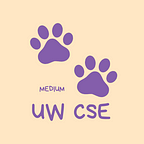Tips and Resources for Career Fair Preparation
Even though the Allen School’s Autumn and Winter Career Fairs have passed, ACM wanted to provide you with some information and advice to help you make the most out of future career fairs!
Although we’re in a department focused on computer science and engineering, we understand that your interests may be outside the realm of software engineering. Many of the internship and job openings from the companies attending the career fair will focus primarily on software engineering roles. But if you have a different interest, such as in working as a program manager or UI/UX designer, some companies are also looking for candidates who are interested in those positions! Below is a list of the common positions, and a little bit about what the role entails. Note that the titles and responsibilities for each position definitely vary from company to company, but we have just provided a general overview of each one.
Software Engineering (abbreviated as SWE or SDE, where D stands for development):
- This is the classic tech role that most people think of when they think of internships in this industry. The responsibilities of this role revolve around the programming and development of the product or service that the team they work for is in charge of. It is important to note that since there are so many different types of software and programming, SWE roles are often broken into more specific categories such as back end, front end, web development, server work, and many more. However, sometimes people work simultaneously in multiple of these categories, depending on what their specific team requires and they may switch between them as well.
Program/Product Manager (often abbreviated as PM):
- This role is responsible for a variety of tasks. Though they are not generally known to be the ones deeply involved in writing the actual code for whatever product or team they are on, they are definitely familiar with it and have a strong understanding of how it works. This is because PMs are in charge of managing all aspects of the product or service that their team works on, usually from the start of its life cycle to the end. This means everything from initiating efforts, design and specification reviews, determining scope and technologies to be utilized, working with partner teams or external clients, managing the programmers and their tasks, getting customer feedback and leading the iteration process, and presenting the product or service both to others in the company or to customers. As seen by the long list of possible tasks, most PMs are involved in a diverse range of work that keeps them very connected to the product and the team as a whole. They often serve as a leader for a team, setting deadlines and developing plans to meet them, tracking progress.
UI:
- UI is the common abbreviation for user interface. Oftentimes the roles in this space could be called UI developer, UI designers, or some other term depending on the company. UI is the space that focuses on the customer viewpoint of a product or service, and how the customer interacts with it, and the aesthetic experience. Some of the key responsibilities of people in the UI space are working with the look and feel which includes branding, user stories, and analysis of the space and research on the design. There are also many technical components involved such as responsive design, adaptation to various devices and screen sizes, interactivity, and accessibility. Often, UI designers are contacted by product managers in order to help structure and design the product before the development team gets to work.
UX:
- UX stands for user experience. This role is one that people often confuse or even combine with UI, however, though there is some overlap and fluidity between the terms, there are definitely some general differences that we can point out. UX designers have similar roles to that of UI designers, but have a stronger focus on the functionality of the product, rather than some of the social and aesthetic aspects that come with doing customer and market research. There is also an emphasis on how each component actually works and fits together. All in all, it is important to remember that both UI and UX roles are very dynamic and diverse, and their definitions really do depend on the specific company and the tasks that they are given.
Other Fields:
- One more thing to note is that there are tech roles in all industries! For example, fin-tech is a big space for technology roles, and there are definitely tech related jobs in healthcare, education, and any other industry you can think of! Hence, if you have a passion for something besides tech or just want to explore a new space, look into positions at companies that may not immediately come to mind when you think about computer science. These roles can be great ways to learn something new and apply your interests or even education if you are potentially minoring or double majoring in something.
It’s important to note that the responsibilities and boundaries of these positions can often be blurred; people working in industry will often change career paths or even use one position as a springboard for another opportunity they have in mind. What’s important is that you explore the variety of opportunities available to you, so you can make an informed decision based on your own values or interests. Though this article does not cover all the possible roles out there, we hope it brings some light to the variety of positions in the tech industry and inspires you to explore all of them and find the aspects you are passionate about!
